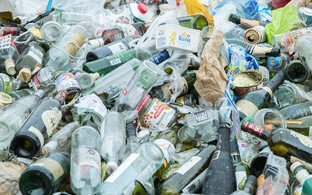
Last fall, Margus Vetsa, visiting lecturer in environmental management at Tallinn University, checked hundreds of municipal waste containers in Tartu, as part of the "PrügiBingo" project, which aimed to find out how keen the city's residents are on sorting their household waste. It turned out, that 96 percent of the mixed municipal waste containers examined, contained waste that shouldn't really be disposed of there.
"The most common type of waste in mixed municipal waste bins, was the kind that should not be there. This was food waste. Then there was plastic and metal packaging, beverage cartons and glass packaging. During the summer, in Tartu's mixed municipal waste (containers), there was too much biodegradable garden waste," said Vetsa.
The City of Tartu itself does not arrange for the collection of plastic packaging. Instead, collections have to be organized individually by each different cooperative or residential building. Ülle Mauer, head of the city's environmental service, said there are thousands of housing associations in the city, which have ordered a container. There are also already 106 containers for the disposal of packaging currently available for use in the city.
In Mauer's view, using public containers to collect plastic waste is not the most efficient approach.
"Today, a new national waste (disposal) plan is being drawn up and I see that the issue of organizing the collection of waste packaging locally ( i.e. by housing associations or residents of individual buildings – ed.) is on the agenda. I think that's really the future. There are so many problems with the public (waste) collection network. The people who are really motivated to sort (their household waste), will go and take it there, but it doesn't appeal to people, who are less inclined to do so. We can't make much forward progress like that," said Mauer.
However, Mauer pointed out, that organizing separate containers for every housing association is not an easy task.
"The responsibility for collecting packaging is put on the packaging organizations, the producers. They organize the collections, by installing the containers or arrange (for collections to happen) from homes," said Mauer.
"If we put forward our conditions now, it presupposes that we have the packaging organizations on board, that they agree. This needs to be a cooperative effort, though at the moment we do not have that cooperation. It would still be best if this happened centrally, so that the 60 local authorities do not (have to) negotiate separately with the three different packaging organizations," said Mauer.
Kaupo Heinma, deputy secretary general at the Estonian Ministry of the Environment, said there was no need to change the system, to one which places the responsibility for disposal on companies, which produce plastic packaging, as the current one works. However, he said that it is not right for plastic packaging disposal units to be located further away from residential buildings than other waste disposal containers.
"It is the responsibility of the producers, those who are in the packaging market, to collect and handle the (waste) packaging. Due to the cost to them of (running) this additional collection network, they have not been prepared to do that," Heinma said.
Siret Kivilo, a board member of the Estonian Recovery Organization, which arranges for the separate collection of waste packaging, said that in many places, particularly those which are sparsely populated, collecting waste packaging directly from people's home may not be a reasonable option.
"It is really convenient to just leave your waste packaging at the doorstep. However, it's then a question of how much (collecting that) would cost and who pays," said Kivilo.
"This does not mean that producers, or packaging companies, should have to pay for absolutely every activity, which arises in relation to waste packaging, including (providing) convenient services such as doorstep collection. In rural areas, where private houses are separated by long distances, does it make sense to send several different machines to collect different types of waste, loading up the roads and streets? How environmentally friendly is that?" asked Kivilo.
Kaupo Heinma said, that by 2025 organizations, which produce packaging will need to recycle 50 percent of their plastic. At the moment, they are only required to recycle around half that amount.







